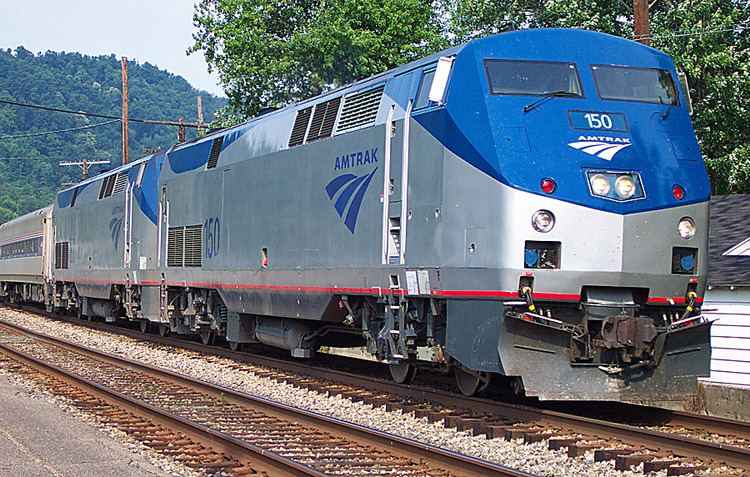 | ||
The rolling stock of Amtrak comprises 396 locomotives, 25 trainsets, and 1,553 rail cars as of the end of 2011.
Contents
Locomotives
Amtrak operates both diesel and electric locomotives. Its electric locomotives are confined to the Northeast Corridor and Philadelphia to Harrisburg Main Line, while its diesels may be found anywhere in the United States.
Future locomotives
In August 2013, the Illinois DOT, in conjunction with Amtrak and other state DOTs, released a joint procurement RFP for 32 high-speed (125 mph), diesel-electric engines for use on intercity corridor and commuter routes. Siemens won the bid with the new Charger engine. Of the 32 base engines, 21 would be allocated for Illinois and Michigan service, 6 would be for Amtrak California service and the remaining 5 being used on the Cascades service in Washington. The contract includes options for up to 75 additional engines for use on intercity corridor and commuter routes, and up to 150 engines for use on long distance routes for a total of 257 engines. The long distance engines would differ mainly in the following ways: larger fuel tank (2,200 gallons vs. 1,800 gallons) and higher HEP capacity (1000 kW vs. 800 kW). Caltrans exercised an option to purchase an additional 14 of the Charger locomotives for use in California in addition to the initial 6 orders for use on the Pacific Surfliner.
Future trainsets
On January 17, 2013, Amtrak announced that it has entered collaboration with the California High-Speed Rail Authority to draft up specifications for the standard high speed train set to be used along the Northeast Corridor and replace the original Acela train sets. The joint order was planned to be for 62 trainsets, with 32 earmarked for the NEC, and having a capacity between 400-600 people.
In June 2014, plans for the joint order were abandoned; according to Amtrak, the two companies' requirements were too different to make a joint order economically and operationally feasible. In September 2015, Amtrak selected Alstom as the builder of 28 Acela replacement trainsets and entered into exclusive negotiations with the company, expected to yield a firm contract worth roughly $2.5 billion by the end of the year.
In August 2016, Amtrak approved the contract with Alstom to make 28 new Avelia Liberty train sets to replace the Acela on the Northeast Corridor with delivery by 2021. The new sets will be capable of running at speeds of up to 186 mph but will initially be limited to 160 mph. Amtrak will be upgrading tracks along the corridor to allow these sets to run at that speed. New sets will be equipped with: More passenger seating, Modern interior design, improved WiFi, USB outlets, High ADA Accessibility and more.
Passenger cars
At the end of 2011 Amtrak rostered 1,553 passenger cars of various types. These include coaches, lounges, dining cars, sleeping cars, baggage cars and crew/dormitory cars.
Business cars
In addition to its regular fleet, Amtrak owns several business and track geometry cars:
Future passenger cars
In July 2010, Amtrak announced an order for 130 single level Viewliner rail cars from CAF USA, with deliveries planned to begin in October 2012. The contract, valued at $298.1 million, was for 55 baggage cars, 25 split baggage/crew dormitory cars, 25 dining cars, and 25 sleeper car. In mid-2014, Amtrak changed 15 of the baggage/dormitory cars to baggage cars. After extensive delays, all 70 baggage cars were delivered by late 2016, with the first diner delivered in November. As of January 2017, the full diner order was slated for delivery by the middle of the year, with the baggage/dormitory and sleeper cars following.
In November 2012, a joint venture led by Sumitomo Corporation and Nippon Sharyo was awarded a contract by the California Department of Transportation (Caltrans) to build 130 bi-level passengers cars for Midwestern and California service. Under the terms of the contract, which used federal funding, Caltrans would own 42 of the cars for Amtrak California service, while a consortium of Illinois, Michigan, and Missouri would own the remaining 88 for Amtrak service out of Chicago. In August 2014, the states ordered 45 more cars—34 for Midwest service and 11 for California. In mid-2015, a prototype carbody failed a compression test, leading to an indeterminate delay in delivery. As of January 2017, no progress had been made on building the cars, and Caltrans, Illinois, Nippon Sharyo, and the Federal Railroad Administration were in negotiations to extend the September 30, 2017 deadline for spending the federal funding used in the order.
Private passenger cars
Although not part of its fleet, private railroad cars may also be hauled by Amtrak trains if suitably certified and equipped with head end power (HEP). Groups such as the American Association for Private Rail Car Owners, Inc., (AAPRCO) represent the interests of car owners in dealing with Amtrak. These private cars may be used by their owners or chartered by individuals for private travel behind scheduled Amtrak trains.
All non-Amtrak cars, including those of the Department of Transportation, receive car numbers in the 800000 series for tracking purposes. In the early years of Amtrak's existence, it required that private cars be marked in the "Pointless Arrow" scheme as the neophyte company worked to stamp out "rainbow" trains with a system paint scheme, but this policy was abandoned as Amtrak matured, allowing car operators to use personalized or heritage schemes.
Former
This is a partial listing of locomotives and rolling stock formerly operated by Amtrak. This does not include equipment inherited from private railroads.
Inherited locomotives
Amtrak inherited numerous locomotives from private railroads on its formation in 1971. Most of these were retired by the end of the decade, if not earlier. These locomotives are enumerated below, with their original owners.
